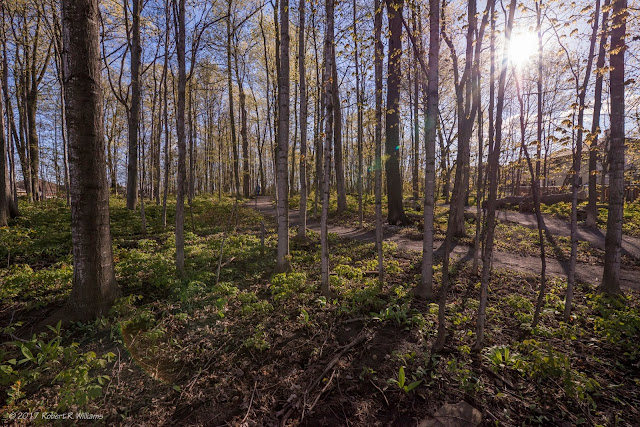 |
| Bloodroot flower using Nikkor 105mm f/2.8 |
To get even greater magnification, I bought an inexpensive Fotodiox 52mm reversing ring (about $20 CAD) to use with an old 50mm lens that I acquired many years ago. This allows me to mount the lens backwards on the camera, which turns it into a macro lens. I added some extension tubes that I had also acquired many years ago to give me 2:1 magnification.
This lens arrangement allowed me to photograph some of the dragonflies and creepy crawly creatures at the cottage. The lens has to be quite close to the subject to get this kind of magnification, which presents problems getting close enough to nervous creatures, and to get enough light on the subject. I added a flash to my camera with a hand-made modifier to reflect the flash 90 degrees down in front of the lens, and this worked well. I was able to capture excellent detail - you can see the individual elements of the dragonfly's compound eye in this image!
 |
| Dragon Fly using reversed 50mm lens with extension tubes, with natural light. |
The reviews were correct on both counts. This lens focuses at about 1cm from the subject, which alone makes it difficult to use. However, I tried my first snowflake using this lens.
To photograph a snowflake, first you have to catch one intact. I used a black polar fleece glove, and with enough patience and the right kind of snowfall (large flakes, little wind, not too cold so to avoid frostbite on my hands), it can be done. Despite wearing gloves, my hands took a beating. They were quite painful as they warmed up afterwards.
After selecting a flake on the glove, I held it up to the lens until I got the snowflake in focus. I found I had to brace my left hand (holding the snowflake glove) against a wall, and move the camera (mounted on my tripod) slowly towards the snowflake. The light was very low not only because it was cloudy, but also due the subject being in the shadow of myself and the camera only a centimetre away. I had to increase my ISO rating to 6400 or higher (Hi 0.3, Hi 0.7 and Hi 1.0 on the Nikon D800) to obtain a shutter speed high enough to take a sharp image. Finally, since the depth-of-field is incredibly narrow, I took many photographs of the snowflake for a focus stack. Eventually I selected about 15 images and stacked them in Photoshop:
 |
| Snowflake using the Mitakon Zhongyi 20mm f/2 macro lens |
I was quite pleased with the result although it isn't perfect, and I have some improvements to make in my technique, including post-processing technique. Getting sharp images ranging from one end of the snowflake to the other is important, and you should be prepared to take 50+ photographs to get every part of the snowflake sharp.
Lighting is a problem since the lens and snowflake have to be so close together. Using ISO 6400 or higher adds a lot of noise to the photograph, which is difficult to manage in the evenutal image. I would much prefer to use ISO 400 or less.
Also, I found that the snowflake can sometimes shift on the glove, move with a bit of wind, or my hand holding the snowflake glove can shift a bit. It's frustrating, but you may have to redo the whole image stack if something like this happens. Steady hands and freezing fingers are a bad combination!
However, there is a lot of potential here, and I have spent less than $200 in total for new equipment.
More on this topic to come.
. . . Rob Williams
http://www.robertwilliamsphotography.ca



























